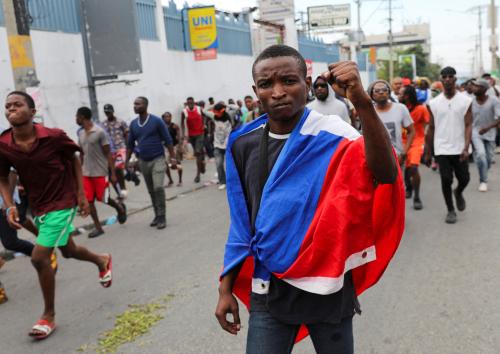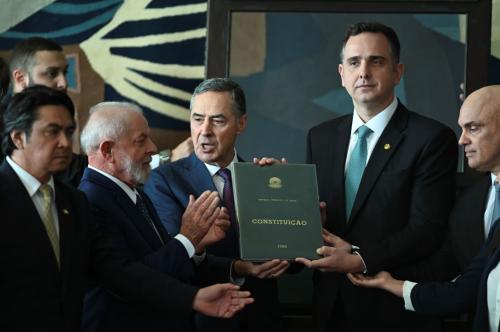The fall of President Gonzalo Sanchez de Lozada, one of the U.S.’s staunchest allies on the continent, via a helicopter escape to Miami last Friday, sent a strong signal that all is not well in our southern hemisphere. Long gone are the days when optimism reigned about Latin America’s turn to markets and democracy, and about the region’s potential to become a competitive player in the world economy. With the exception of a few star performers, such as Chile and potentially Brazil, the panorama in the region is a remarkably depressing one.
Venezuela, where democratic government has already been undermined, teeters on the edge of social explosion. The Uribe government in violence-stricken Colombia is hinging its remaining fragile hopes on an upcoming referendum. The Toledo government in Peru has approval ratings as low as 10%, and the violent Shining Path is showing the first signs of resurgence since its demise over ten years ago. Ecuador has been on the brink of instability for several years, and Argentina, while better off than at the height of its crisis, has still to find a solution to many of its structural problems. Throughout the region, in the face of flat growth rates for several years in a row, the public has begun to question the distribution of the gains from the turn to the market – not a surprise in the most unequal region in the world.
The situation in Bolivia, South America’s poorest country, is particularly worrisome. The fall of “Goni” as he is known, was a tragedy and an irony. Goni — whose second term in office lasted just 14 months — took office amidst a tide of anti-market and anti-U.S. sentiment. Public opinion was jaded by the economic spill-over from the Argentine crisis, by mismanagement of a major water privatization, and by resentment against U.S. sponsored coca-eradication policies.
Goni then attempted two reforms that galvanized negative public sentiment. The first was the introduction of an income tax. It resulted in poorly paid policemen — who were eligible for the tax — rioting against the army. The second was a proposal to export natural gas to the U.S. through Chile. Most Bolivians credit the Chileans for “stealing” their access to the sea. The tax proposal was a way to generate sorely needed public revenue. The $5 billion gas deal was expected to raise poor Bolivia’s GDP by a percentage point. Yet both stirred up latent public sentiment to the point of no return, and ultimately resulted in Goni’s resignation.
The irony is that in Goni’s first term in office, from 1993-98, he did more than any other leader in the region to spread the benefits of market reforms. He introduced a new form of privatization — capitalization — in which half the proceeds from the process were to be delivered to elderly Bolivians in the form of solidarity bonds. He introduced a new way of delivering social services — Popular Participation — to channel public resources and decision-making power to the local level. Both reforms were reversed or partially reversed by his successor, General Hugo Banzer.
How about the U.S. role? In the eyes of the average Bolivian, U.S. policy is simply coca eradication. Goni cooperated with the eradication program, while at the same time trying unsuccessfully to convince the Administration that it was under-funded and causing political difficulties.
Beyond coca, it is difficult to identify any tangible U.S. policy to criticize, because the U.S. has completely neglected the region since September 11. The Argentine crisis occurred — and was resolved — in spite of rather than due to U.S. efforts. Policy towards Venezuela is vacuous at best. Goni’s cries for assistance in Bolivia fell on deaf ears. And the promised free trade area of the Americas is nowhere in sight.
Yet is it as bad as it seems? Will Latin America turn away from markets and to authoritarian regimes yet again? In a recent paper based on data from the region-wide Latinobarometro poll, Sandip Sukhtankar and I find that public support for privatization has dropped precipitously in the region, as has satisfaction with how both democracy and the market are working in individual countries. At the same time, preference for democracy as a system of government has increased, as has support for the market as a system. Those trends are most notable in the “crisis” countries, simply defined as countries with negative GNP growth in 2002.
Rather remarkably Latin Americans also remain as optimistic as before about their children’s chances of getting ahead. And rather surprisingly, support for lowering taxes is negatively correlated with wealth, suggesting that the wealthy in the region are seeing the merits of progressive taxation, perhaps for the first time. Thus respondents are increasingly distinguishing between democracies and markets as systems and how they are operating in their particular countries or contexts. This is a positive sign and also demonstrates remarkable resilience in the region.
But that is the good part of the story. The bad part is that democracies and market economies are being shaken to the core, insurgent movements are on the rise in many countries, and the U.S. has demonstrated remarkable complacency in the face of these trends. We have now lost one of the most enlightened and committed economic reformers in decades, and his country is teetering on the brink of disaster. How many more major national crises will it take before the Administration wakes up and looks south?



Commentary
Op-edCrisis in Bolivia, Dominoes in Latin America?
November 11, 2003